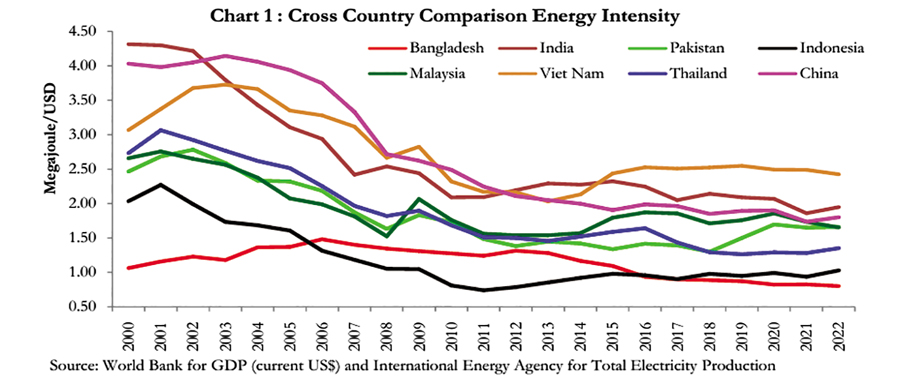Electricity consumption data: an incomplete proxy for economic activity

Md Ezazul Islam, Mahmud Salah Uddin Naser, Md Omor Faruq, and Ahsan Ullah
Published :
Updated :

Bangladesh Bureau of Statistics (BBS) has been compiling and publishing national accounts since 1972. According to the BBS, nominal gross domestic product (GDP) stood at US$459 billion in FY24. Recently, Citibank Capital, a subsidiary of City Bank PLC, published a report titled Macroeconomic Outlook 2025: Bangladesh, in which it estimated nominal GDP at $300 billion for FY24, using electricity production data published by the Bangladesh Power Development Board (BPDB).
By comparing nominal GDP data from a few regional countries for FY24, the report suggested that nominal GDP of Bangladesh was overestimated by around 35 per cent in FY24. Some of the media outlets in Bangladesh also published reports based on the claim made by Citibank Capital.

The BBS compiles GDP based on the concepts, definitions, classifications, and methodology outlined in the best practice document System of National Accounts, 2008 (2008 SNA). The SNA is the internationally agreed standard set of recommendations on how to compile measures of economic activity in accordance with strict accounting conventions based on economic principles. It has been produced and is released under the auspices of the United Nations (UN), the European Commission (EC), the Organisation for Economic Co-operation and Development (OECD), the International Monetary Fund (IMF), and the World Bank (WB) Group. The IMF and WB regularly provide technical assistance to the BBS to improve the GDP compilation process. Furthermore, an Advisory Committee, or technical committee, headed by renowned economist Prof Wahiduddin Mahmud, was established to review the methodological appropriateness of the GDP compilation. The committee oversaw and contributed to the effective compilation of the new GDP series, with 2015-16 as the base year without interference from the interim government.
The BBS has been rebasing GDP approximately once a decade since 1972 to capture structural changes in economic activities, consumption patterns, savings behaviour, and relative price changes. The size of GDP increased with the rebasing, due to the inclusion of new and emerging sectors of the Bangladesh‘s economy in the GDP compilation process. The BBS has rebased GDP four times, with base years 1984-85, 1995-96, 2005-06 and 2015-16 resulted in volume increases of 4.96 per cent, 27.73 per cent, 15.21 per cent, and 19.79 per cent respectively.
Chart 1 displays historical data on energy consumption per unit of output, commonly referred to as energy intensity, for various countries. The chart demonstrates that, with a few exceptions, Bangladesh has maintained the lowest energy intensity level among these countries. Lower energy intensity may suggest that the Bangladesh‘s economy is labour-intensive, as sectors such as agriculture, textiles, and services typically use less energy than a more industrialised or manufacturing-based economy.
The ratio of energy use to GDP is not an ideal indicator of energy efficiency or technological development. The ratio depends much on the structure of the economy as on the energy intensities of sectors or activities and changes in the ratio over time are influenced almost as much by change in the structure of the economy as by the changes in the structure of the economy as by the changes in the sectoral energy intensities.
Estimating Bangladesh GDP based only on electricity consumption data may lead to inaccurate estimates of nominal GDP for several reasons such as exclusion of non-electricity using sectors, change in the source of electricity production, improvement in labour productivity, or growth in sectors with low energy consumption. Additionally, when calculating measurements for different countries using GDP, it is preferable to use GDP based on Purchasing Power Parity (PPP) rather than nominal GDP.
PPP-based GDP is calculated by dividing nominal GDP by the PPP exchange rate. The latter reflects the purchasing power of the national currency relative to that of the US dollar in the USA. The International Energy Agency (IEA) also uses GDP based on PPP to compile energy intensity data.
While calculating Bangladesh‘s GDP, many sub-sectors that do not using electricity for production. Additionally, while various mechanical tools are utilised in agriculture, fishing, and other service sectors, many of these tools do not operate on electricity. As a result, estimating GDP solely based on electricity production data could yield inaccurate nominal GDP figures.
In conclusion, while electricity production data can offer some insight into economic activity, relying solely on it for estimating GDP is likely to overlook significant factors and result in a skewed or inaccurate estimate of nominal GDP.
Dr Md Ezazul Islam, Executive Director; Mr Mahmud Salah Uddin Naser, Director; Dr Md Omor Faruq, Additional Director; Mr Ahsan Ullah, Joint Director; Monetary Policy Department, Bangladesh Bank. ezazbb@gmail.com
The piece is originally published as a policy note in the Monetary Policy Review 2024-25. www.bb.org


 For all latest news, follow The Financial Express Google News channel.
For all latest news, follow The Financial Express Google News channel.